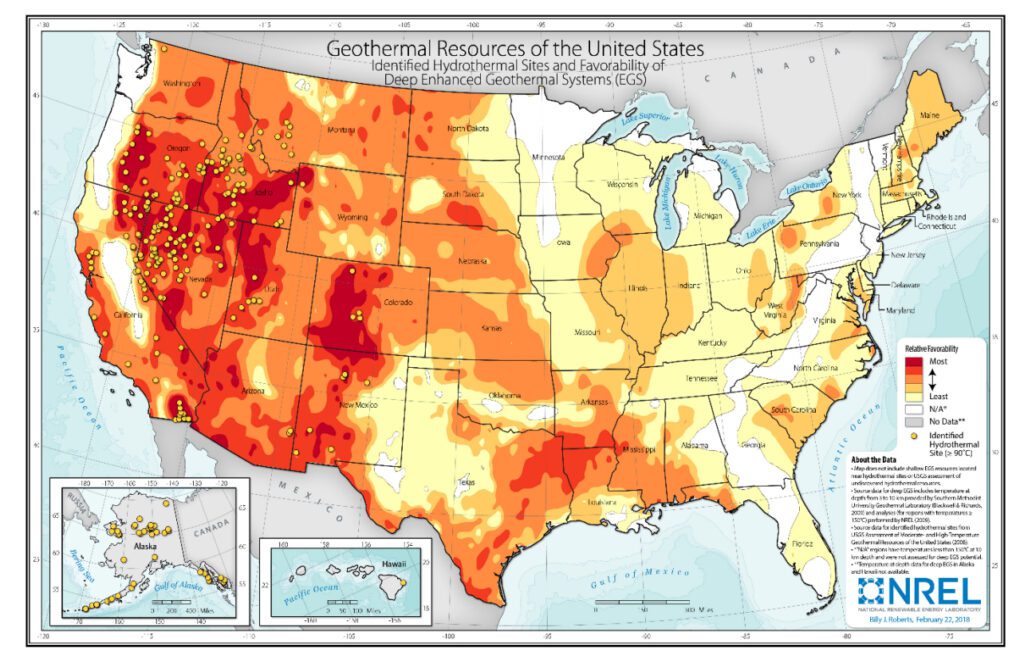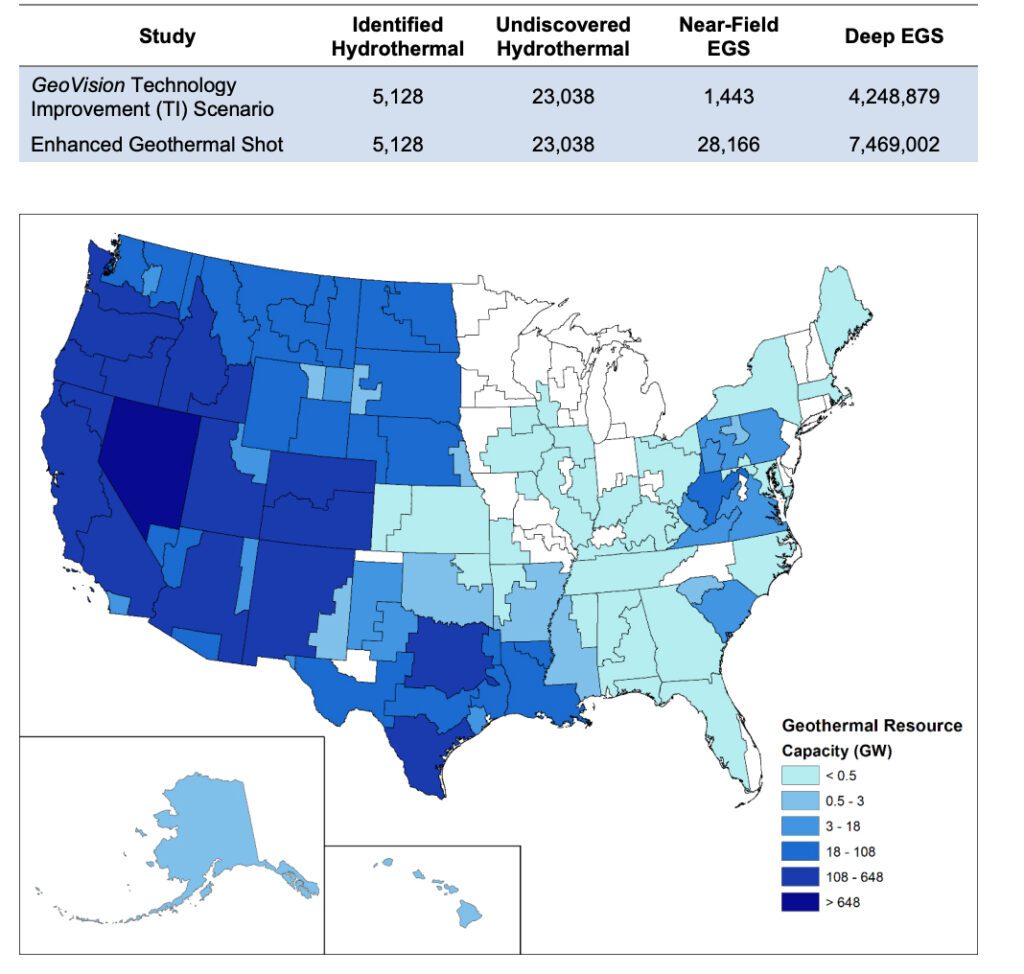DOE Dedicates Funding for Up to Seven EGS Geothermal Pilot Demonstrations
The Department of Energy has moved to fund up to seven pilot enhanced geothermal system (EGS) projects to demonstrate different geologic settings, a variety of development techniques, and different well orientations.
The U.S. agency on Feb. 8 announced up to $74 million to support the EGS pilots, for which the November 2021–enacted Infrastructure Act designates $84 million. The DOE said it would accept applications for the Congressionally funded EGS pilots over multiple rounds. First-round letters of intent are due March 8, 2023, and first-round applications will be due July 7, 2023. The DOE said it expects to announce its first-round selections in October 2023.
The funding announcement opportunity (FOA), however, may remain open for up to 48 months, with review cycles occurring every eight months. “The ‘rolling’ nature of this announcement is meant to accommodate our community of applicants, who may need time to find the appropriate mix of experience to develop effective teams and to identify high potential sites, perform critical due diligence on those sites, and accommodate operational restrictions on sites before applying,” the DOE said. “In addition, DOE recognizes a perennial challenge given the small size of the geothermal industry, which makes it more difficult for personnel to be available to support the DOE FOA application and project management process.”
A Boost for Federal Efforts to Make EGS Economical
The FOA follows the DOE’s roll-out in September 2022 of an EGS Energy Earthshot, an integrated program that seeks to cut the cost of EGS to $45/MWh by 2035, an ambitious goal that would shave current EGS costs by 90%.
EGS are advanced engineered geothermal reservoirs that involve drilling deep wells (at depths of 3 to 10 kilometers) underground in hot rock at temperatures of 175C to more than 300C, but where there is little to no natural permeability or fluid saturation. “During EGS development, subsurface permeability is enhanced via safe, well-engineered stimulation processes that re-open preexisting fractures, create new ones or a combination of both,” the DOE’s Geothermal Technologies Office (GTO) says. “These open conduits increase permeability and allow fluid to circulate throughout the hot rock. The fluid transports the otherwise stranded heat to the surface where clean, renewable electricity can be generated with current power generation technologies.”
But while geothermal resources naturally occur everywhere on Earth, harvesting them cost-effectively has been challenging, owing to variability in rock temperature, permeability, and other conditions. Efforts to explore EGS have been ongoing since the 1970s. Most have remained small in scale, mainly owing to insufficient reservoir volume, difficulty with drilling, and induced seismicity.

Under the new FOA, the agency will explore four topics as part of its EGS pilot demonstrations. Under Topic Area 1, EGS demonstrations will utilize existing infrastructure that is close to existing geothermal or hydrothermal development. The topic aims to explore projects “with immediate potential for electrical power production,” and it sets a goal of increasing the output of existing reservoirs by at least 5 MW per site or well.
Topic 2 will explore “green field” sites,” well-characterized sites with no existing geothermal development, but which have potential for sedimentary, igneous, or mixed metamorphic rock with near-term power production potential.
Under Topic 3, demonstrations will address super-hot or supercritical EGS resources (of more than 375C). Under Topic 4, EGS demonstrations will be located at “a well-characterized eastern U.S. site” with near-term power and thermal power production potential. Topic 4, however, will not be open for applications until the second round of the DOE’s FOA.
NREL: Earthshot EGS Cost Reduction ‘Ambitious but Achievable’
The FOA, notably, comes on the heels of a Jan. 25–released report by the DOE’s National Renewable Energy Laboratory (NREL) that suggests the federal goal under the EGS Earthshot to “significantly” expand EGS deployment by cutting costs 90% to $45/MWh by 2035 is “ambitious but achievable with technology advances.” NREL’s forecast using updated EGS supply cost curves (generated by the Regional Energy Deployment System [ReEDS] capacity expansion model) suggests the total amount of installed geothermal in the U.S. could grow to 38.3 GWe by 2035 and 90.5 GWe in 2050. Geothermal energy currently generates about 3.7 GW of electricity in the U.S.
After accounting for current deployments, land restrictions, and likely barriers to development, the NREL report concludes that 5.1 GWe of identified hydrothermal resources and 23,038 MWe of undiscovered hydrothermal resources are available for development.
Near-field EGS resources—“areas around hydrothermal sites that are elevated in temperature but lack sufficient permeability and/or in-situ fluids to be economically produced as a conventional hydrothermal resource”—present a 28.2 GWe potential. Developing these near-field resources, however, will require the application of EGS reservoir engineering techniques to produce economic power, the report suggests. Meanwhile, the nation’s deep EGS resource potential—made up of heat trapped deep in the Earth that can be found virtually anywhere—is “huge,” the report suggests. “The result is an additional 3,000 GWe of EGS resource potential added for the Enhanced Geothermal Shot analysis,” it says.

For its part, the DOE has been exploring EGS since 2015 at the Utah Frontier Observatory for Research in Geothermal Energy (FORGE), its dedicated underground field laboratory situated near the town of Milford on the western flank of the Mineral Mountains. FORGE in April 2022 marked a significant milestone with the successful completion of its first large-scale 10-day stimulation in a deep-deviated well. (Read POWER’s in-depth story here: “Large-Scale Enhanced Geothermal System Trial Successfully Completed.”) As POWER has also reported in-depth, several private-sector EGS projects are meanwhile making gradual progress, driving interest and investment in hot-rock development.
—Sonal Patel is a POWER senior associate editor (@sonalcpatel, @POWERmagazine).